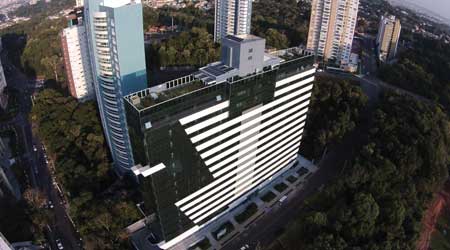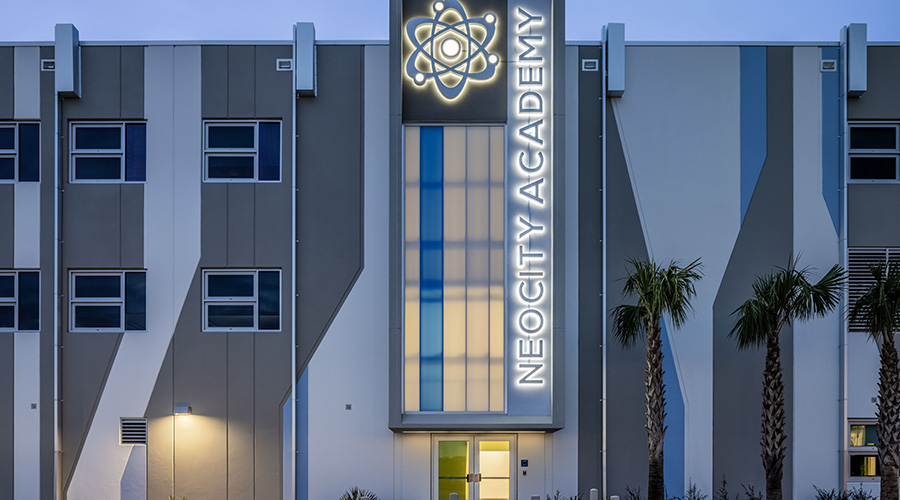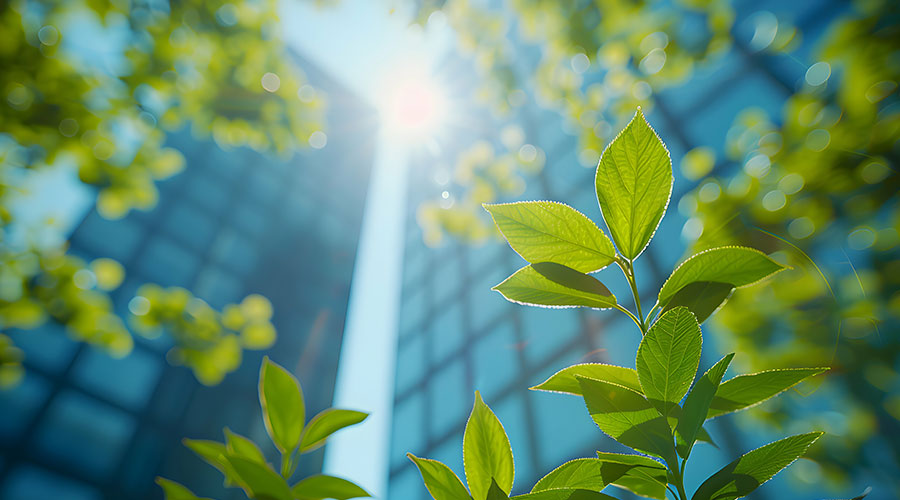 The Eurobusiness office in Curitiba, Brazil, is the world’s first LEED Zero Water building. The 14-story LEED Platinum building marries water efficiency and resilience by treating 100 percent of its wastewater onsite.USGBC
The Eurobusiness office in Curitiba, Brazil, is the world’s first LEED Zero Water building. The 14-story LEED Platinum building marries water efficiency and resilience by treating 100 percent of its wastewater onsite.USGBCHow LEED Guides Users to Water Efficiency
LEED has provided further emphasis on water efficiency, and LEED Zero Water takes that to the nth degree. Here are a few water efficiency success stories.
Green building rating systems, such as LEED, incorporate water efficiency and management as core sustainability outcomes. LEED approaches water efficiency from a performance perspective. The LEED for Building Operations & Maintenance: Existing Buildings rating system, or LEED O+M: Existing Buildings, rewards projects that achieve high efficiency for indoor and outdoor water use. Another practice that is rewarded is reducing cooling tower water use either through achieving the minimum water reuse cycles or using technology that doesn’t require a cooling tower.
LEED O+M: Existing Buildings also credits projects for rainwater management that reduces runoff volume and improves water quality by replicating the natural hydrology and water balance of the site by using low-impact development practices to capture and treat water from 25 percent of the impervious surfaces for the 95th percentile storm event.
The American Geophysical Union’s (AGU) Washington, D.C., headquarters building is a great example of optimizing water systems. AGU undertook a deep renovation of its existing building with the intent to reduce emissions of greenhouse gases and to attain net zero energy. But the project’s water achievements are also impressive. The building collects rainwater from the roof to reduce water and sewer utility bills and will filter and condition water, producing all the water needed for toilets and on-site irrigation and achieving 62 percent reduction in potable water consumption, earning all LEED water efficiency points.
With LEED v4.1, USGBC is focused on data for documentation as a way to track performance in energy, water, waste, transportation, indoor air quality, toxin-free environments, and occupant satisfaction. LEED v4.1 awards water efficiency points based on a water performance score, which rates the building’s total water consumption against the total water consumption of comparable high-performing buildings. The score is a value from 1 to 100 based on the project’s water consumption per occupant and water consumption per floor area over a 12-month period. This streamlined, outcome-based approach holds promise for advancing efficiency and resilience in existing facilities.
For building owners and facility managers taking a leadership approach to water, LEED Zero Water is worth considering. USGBC launched LEED Zero certification about a year ago around the Global Climate Action Summit to recognize LEED projects that perform at a net zero level for a given resource – carbon, energy, water, or waste – and proven with 12 months of operating data. LEED Zero Water focuses on balancing potable water use against alternative sources of water and returning water to its natural source. The certification is intended to recognize leadership and highlight innovative water management strategies.
The first building in the world to achieve LEED Zero Water certification was the Eurobusiness office in Curitiba, Brazil. The LEED Platinum 14-story building treats 100 percent of its wastewater (gray and black) onsite through a constructed wetland located on its roof. The treated wastewater is later reused for toilet/urinal flushing or infiltrated on-site (returned to source). No chemicals are used in the treatment process and potable water is supplied by an onsite artesian well.
The municipal building code required that graywater be treated and reused and a rainwater catchment basin be installed to reduce runoff rates. A conventional design approach would have placed these systems underground, taking up the space of two parking spots. To reduce first costs and free up parking space, rainwater was stored on the roof instead. A 20-centimeter-deep “pool” of water covers the entire surface of the roof deck. A raised floor system designed for exterior use is topped with fine gravel and planted with macrophytes, or aquatic plants that thrive growing in or near water. The entire assembly functions as a constructed wetland and constitutes part of the wastewater treatment system.
Replicating natural systems proved to be the most economical solution to treat the building’s wastewater. It also allowed for the treatment of both gray and black water at no additional cost. In the end, the parking spaces paid for the system. Efficient fixtures and fittings were used to reduce potable water consumption and the amount of wastewater generated. This was critical to the design’s success as the available roof, or wetland, area was limited. The building was designed to use 45 percent less water and, when alternative sources were factored in, total potable water use was reduced by 82 percent.
The building uses multiple alternative onsite water sources, including captured rainwater, condensate from air handling units, subsurface infiltration, and gray and black water. About 65 percent of all water used was reclaimed, and the building only utilizes municipally treated potable water as a back-up. According to Guido Petinelli, the LEED consultant on the project, the building already had meters installed for both potable and alternative water sources, making is easier to measure data for a year and demonstrate that LEED Zero Water requirements had been met. The developer and investor on the project, Marcos Bodanese, saw the certifications and sustainability decisions as the right thing to do. Now, LEED Zero provides the opportunity to measure and verify performance, while also supporting resilience efforts.
Life cycle cost savings
Building owners and facility managers can often justify water efficiency projects – stand alone or in conjunction with energy efficiency or other building upgrades – with life cycle cost analyses. Analyses should seek to include energy savings as well as water and wastewater utility savings associated with the project. As these projects help facilities to better withstand storms or to return to operation faster, tangible resilience benefits can have significant financial value. Lost business revenue from extended closures can be a major cost of a storm, beyond physical property damage.
So, while energy efficiency continues to play a vital role in cutting carbon and putting the building sector on a more sustainable path, water efficiency remains an unsung opportunity for many projects. Building owners and facility managers looking to demonstrate leadership and improve resilience should see water efficiency as a priority and a necessary next step.
Related Topics:














